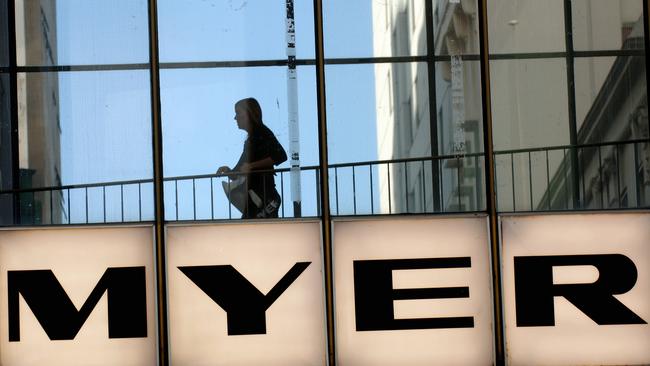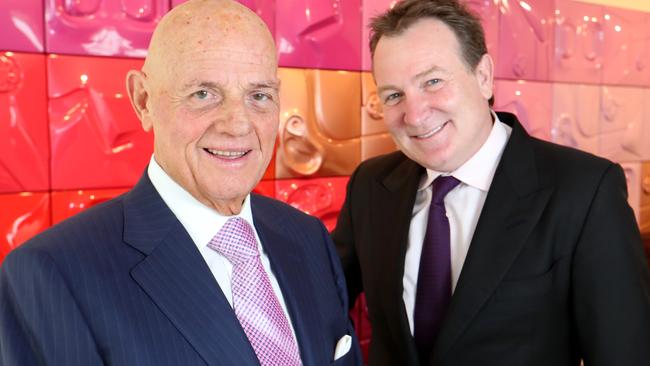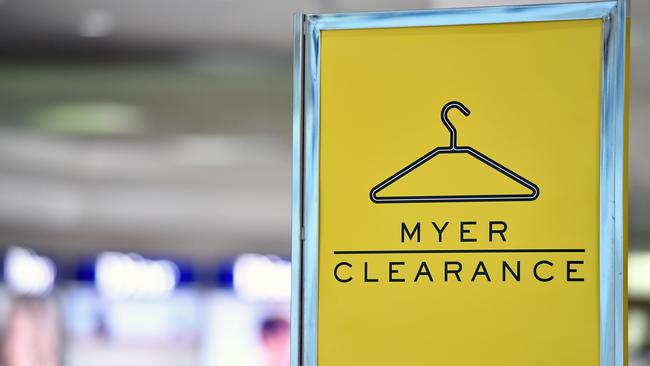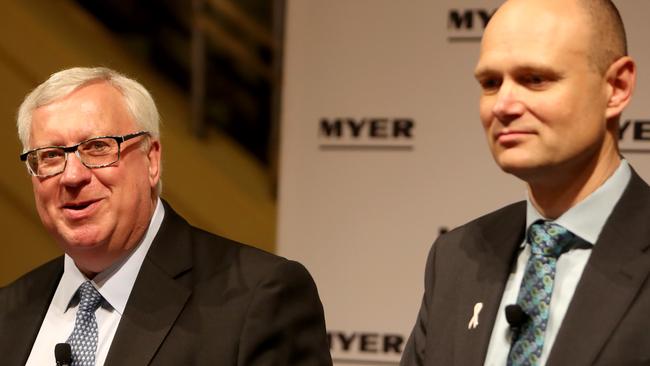Radical change needed to save ‘in peril’ Myer department store chain
ONE of our oldest retailers is facing an uncertain future with falling sales, no CEO and a strategy in tatters. Now industry watchers say only radical change can save it.
THE Friday before last, Myer’s now former chief executive Richard Umbers stood at the top of a staircase in the company’s flagship Sydney CBD store.
Music blasted from speakers, dancers twirled around him and bright ticker tape burst from the skies as the retailer announced a deal to sponsor the city’s Mardi Gras festival.
Amid the excitement and colour, Mr Umbers might have gazed down at all he was custodian of — a 117-year-old Australian retail icon with an annual revenue of more than $3 billion.
It was one of his last public appearances while in charge. Less than a fortnight later, with far less fanfare, Mr Umbers was gone.

On Wednesday, Mr Umbers officially resigned, but chairman Garry Hounsell’s language was blunt: “We are impatient for a turnaround in the company’s performance.”
Some retail watchers have said it may already be too late for the store that began its life in Bendigo in country Victoria. They say Myer’s days as a main street staple may be numbered unless there is radical change.
Pippa Kulmar, a director at consultants Retail Oasis, told news.com.au Myer had failed to engage younger, more digital savvy shoppers. The business was too focused on customer data and had stopped taking risks that had consequently left customers uninspired.

“Myer is lost and it comes back to understanding who the customer is. They had a model that worked for a particular point in time, but the market has changed,” she told news.com.au.
“They’re stuck in a difficult position. They’ve been undergoing a transformation for a while now but the market is moving at such a rapid pace, retailers need to move quickly and that’s never been more important.”
It was in September 2015 that Mr Umbers, an affable and well-regarded veteran of Australia Post and Woolworths, launched the $600 million “New Myer” strategy.
In his own words, the plan would lead to an “energetic revitalisation of Australis’s best-loved retailer”.
Underperforming stores would be closed or shrunk in size and there would be innovations like entire floors dedicated to clearance stock.

More staff would be on the shop floor, a 25 per cent stake was taken in the Australian arm of UK fast fashion retailer Topshop and Myer would have “a market-leading, omni-channel capability”.
Closing unprofitable stores made sense as did investing in online. But the Topshop link-up was a disaster as Myer found itself lashed to a sinking ship which now has just three stores left in Australia. The expensive Topshop concessions in Myer stores had to be swiftly stripped of branding and became discount racks before being dismantled altogether.
However, it was the numbers that really sunk Mr Umbers. He had promised sales growth of 3 per cent by 2016.

It didn’t happen. Up to the end of November sales were down 2.6 per cent year on year. During the critical early December Christmas period, sales tanked by 5 per cent compared to 2016. And as for the actual Boxing Day sales, well they didn’t save the boss’s bacon either, being down 6 per cent.
Sales were so volatile, discounting so deep and the retail sector such a catastrophe that the company couldn’t even advise in what range its 2018 profits would land.
Vultures were circling the troubled department store. Retail heavyweight Solomon Lew, who owns Just Jeans and Smiggle and is Myer’s biggest single shareholder, has been openly critical of the company’s strategy.

Mr Lew’s Premier Investments firm, which is run by former David Jones chief executive Mark McInnes, is pushing for a clear-out of the Myer board.
In a statement on Wednesday, he said Myer’s very future was now under threat.
“It is clear from Mr Umbers’ departure that not only the board-endorsed ‘New Myer’ strategy, but also the ‘New, New Myer’ strategy are dead and buried.”
He also hit out at the lack of retail experience in management ranks. “Any remaining doubt that Myer is in peril should now be removed from the minds of all of shareholders.”
Mr Hounsell, who will take over as the temporary Myer boss, denied to The Australian that the company was on the path to going bust.
“I don’t believe there is any risk of going into administration at this particular point in time,” he said.
Far from scrapping Mr Umbers’ strategy, he said it wasn’t progressing fast enough and more costs could be cut. That may mean further store closures but the company is hamstrung by eye-wateringly expensive lease agreements with the likes of Westfield, many of which don’t expire for years.

Retail misery loves company and Myer is not alone in struggling to work out how to prise open customers’ wallets.
Wesfarmers has written down the value of Target, while South Africa’s Woolworths has done the same with David Jones. H&M’s Australian sales sunk 6 per cent in the three months to November while Gap has shuttered its last store in Australia.
Ms Kulmar said Baby Boomers, Myer’s core demographic, were no longer the dominant shopper. Younger customers were heading online and Myer, like many traditional retailers, didn’t yet have an all-singing, all-dancing digital offer.

There was also too much focus on data and customer metrics: “You have to marry data with intuition and being a step ahead of customers. It’s about creativity, experience and curation — it’s difficult to quantify and data can’t tell you what to do.
“The Australian fashion retail market is incredibly intense and when you’re essentially offering the same product that can be found in another mall down the road, what’s the thing that makes someone choose you?” Ms Kulmar asked.
“It can’t be convenience because online has that so it’s service, personalisation and the instore experience.”
The only growth in department stores, she said, was at the luxury end. Selfridges in Britain and Nordstrom in the US were succeeding with fewer, more up-market stores which had become tourist magnets.

However, there’s a roadblock to Myer becoming the Selfridges of the southern hemisphere — David Jones is already angling for that space. Indeed Myer’s woes have reignited speculation the pair may finally merge and form a single chain.
But Ms Kulmar said Myer, in some form, would survive.
“There’s a genuine want from the Australian public for Myer to succeed; it has a place in our hearts.
“They will need to change. It’s hard but it’s exciting, and particularly when you are most hurting that’s when you’re most open to change.”




